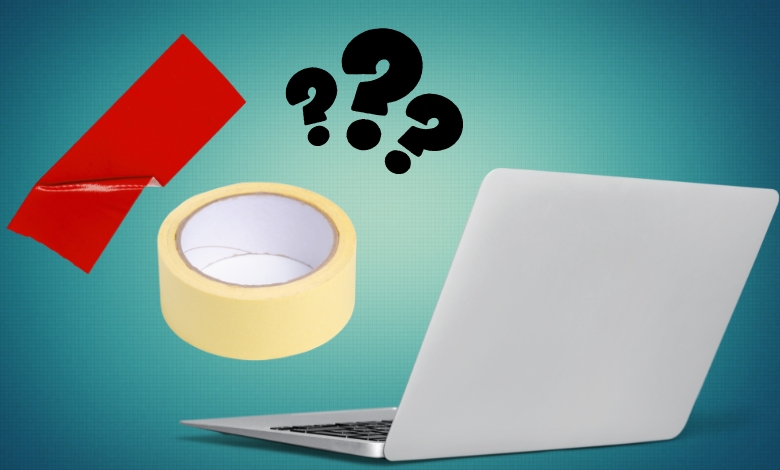Discover what tape will stick to a nonstick laptop surface and ensure reliable adhesion for your projects and repairs.
Have you ever tried to attach something to your laptop, only to find that no tape seems to stick? You’re not alone!
I remember when I was prepping for a conference presentation and needed to temporarily attach some notes and a device to my laptop.
After some research into different adhesives, I finally found a solution.
I thought some tape would work, but everything I tried just peeled right off after a few minutes.
It was so frustrating.
If you’re dealing with the same issue, you might be wondering what tape will stick to a nonstick laptop surface.
In this article, I want to share everything I’ve picked up so that you can avoid the same mistakes I made while trying to protect your business.
Let’s dive in.
Article Breakdown
The Quick Fix: What Tape Will Stick to a Nonstick Laptop Surface?

Let’s cut to the chase.
If you need tape that sticks to those slick laptop surfaces, go for heavy-duty options like 3M VHB (Very High Bond) tape or Gorilla Tape.
These tapes are specially made to stick to the smooth, low-energy surfaces we usually see on laptops, giving you a strong and reliable hold.
Nowadays, most high-end laptops have these fancy nonstick finishes made from materials such as aluminum, magnesium, or plastic composites.
While these surfaces do a great job at resisting fingerprints and scratches, they can be a hassle when you want to attach something to them.
That’s where you need a tougher adhesive.
Why 3M VHB and Gorilla Tape Are Great Choices:
Both of these tapes may seem like overkill for everyday use, but when you’re working with nonstick surfaces, you definitely want something robust.
Why Regular Tape Doesn’t Stick
Let’s discuss why your everyday office tape might not work as well as you’d like.
Tapes like Scotch tape, masking tape, and even regular duct tape are meant for general use.
They’re perfect for sticking to paper or cardboard because those surfaces have enough texture for the tape to hold onto.
But when you try to use them on nonstick surfaces, like the back of a laptop, they just don’t stick well enough.
The Science Behind It:
The main reason is that laptop backs are considered “low-energy surfaces.”
To keep it simple, surface energy is all about how well something can stick to a material.
Nonstick surfaces have low surface energy, making it tough for tape to create a strong bond.
On the other hand, surfaces with high energy, like wood or glass, are easier for adhesives to stick to because they naturally attract them.
It’s like trying to write with a marker on a smooth, greasy surface—you’ll notice it just won’t stick unless you use a special kind of marker.
Alternatives to Tape: When All Else Fails
Sometimes, even the best tape doesn’t give you the results you want.
That’s when you should consider using alternative adhesives.
For example, when I was getting ready for my conference presentation and tape wouldn’t stick, I decided to look for other solutions.
Here’s what I found that worked for me, and what could work for you, too.
Adhesive Putty
You might know it as poster putty or mounting putty, but this soft, moldable adhesive is a real lifesaver.
It’s perfect for temporary holds on nonstick surfaces because it shapes itself to the texture, giving you a stronger grip.
Plus, it doesn’t leave a sticky mess like tape can.
If you need to attach something light, like notes or small items, putty is a fantastic option.
Silicone Adhesive Strips
Another great choice is silicone-based adhesive strips.
People usually use these for attaching small items at home, like hooks on smooth bathroom tiles, but they work just as well on slick laptop surfaces.
They’re designed to handle moisture and heat, so they’re reliable in many different situations.
I’ve used silicone strips to keep a cable organizer attached to my laptop during travel, and they stayed secure even after being tossed around in my bag.
Practical Steps: How to Properly Apply Tape or Adhesive
Even with the right tape or adhesive, the way you apply it really matters.
I learned the hard way that skipping this step can lead to peeling tape and a lot of frustration.
Here’s what I suggest:
Step 1: Clean the Surface
Before you apply any tape or adhesive, make sure to clean your laptop surface well.
Dust, oils, and fingerprints can stop the adhesive from sticking properly.
I recommend using some isopropyl alcohol (the higher the percentage, the better) on a microfiber cloth.
This will eliminate any residue and give you a clean surface for the tape to stick to.
Step 2: Measure and Cut
Once your surface is ready, cut the tape or adhesive to the right size.
If you’re using double-sided tape like 3M VHB, cut it to cover as much area as possible without hanging over the edges. This will create a stronger bond.
Step 3: Apply Pressure
Here’s a tip I learned: apply pressure and hold it.
After placing the tape or adhesive, press down firmly for at least 20-30 seconds.
This activates the adhesive and helps it stick well to the surface.
If you’re using something like Gorilla Tape, make sure to press it down with your fingers or a flat tool to remove any air bubbles.
When to Use and When Not to Use Tape on Your Laptop
Using tape to attach things to your laptop can be really handy, but there are definitely times when it’s not the best idea.
When It’s Okay:
When to Avoid It:
Trial, Error, and Success
You know, I can’t even count how many times I went through that annoying process of applying tape, waiting, and then seeing it peel off just a few minutes later. It felt like I was in a losing battle.
But after all that trial and error, I finally realized that having the right tools makes a huge difference.
I still remember the first time I used 3M VHB tape—it completely changed the game for me.
After I cleaned my laptop, applied the tape, and held it down for about 30 seconds, I was fully expecting it to come off again. But guess what? It didn’t!
That strong bond stayed in place, and I felt such a huge sigh of relief.
No more messing around with papers that wouldn’t stick and gadgets sliding around.
Now you know that what tape will stick to a nonstick laptop surface. So, what I really want you to take from this article is that there’s always a solution out there. It might take some trial and error, but once you find the right tool, you’re all set.
Key Takeaways
- Best Tape Options: If you need tape for your laptop, go for 3M VHB tape or Gorilla Tape. These strong adhesives work great on smooth surfaces.
- Alternative Solutions: If tape doesn’t do the trick, think about using adhesive putty or silicone strips.
- Proper Application: Remember to clean the surface first, press down firmly, and don’t tape over any ventilation areas.
P.S. If you’re like me and have struggled with tape not sticking, you’re definitely not alone. Now you have the solutions you need to tackle this challenge! Whether you need something temporary or a long-lasting fix, there’s always a tape (or adhesive) that can get the job done. You just have to find what works best for you.



